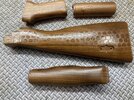Not sure where to post this thread on "stock refinishing", so here goes.
I recently bought a new American Walnut stock set (stock, upper/lower hand guards & grip) for my AK-47. When the set arrived, I noticed that the plastic bubble wrap around the stock partially melted on the wood during the shipping period thanks to the recent heat wave (see photo attached). The retailer was great and told me to keep the damaged set and then sent a new replacement set. Unfortunately, the new undamaged stock is noticeably darker than the rest of the parts in either set.
I don't want to hassle the retailer again, so I have two questions:
1. Anyone have any suggestions on how to remove the plastic on the first stock without ruining the finish, or;
2. If I lightly sand the new undamaged stock, will that possibly "lighten" the walnut color to match the rest of the set?
Looking forward to any constructive advice. Thanks in advance.

I recently bought a new American Walnut stock set (stock, upper/lower hand guards & grip) for my AK-47. When the set arrived, I noticed that the plastic bubble wrap around the stock partially melted on the wood during the shipping period thanks to the recent heat wave (see photo attached). The retailer was great and told me to keep the damaged set and then sent a new replacement set. Unfortunately, the new undamaged stock is noticeably darker than the rest of the parts in either set.
I don't want to hassle the retailer again, so I have two questions:
1. Anyone have any suggestions on how to remove the plastic on the first stock without ruining the finish, or;
2. If I lightly sand the new undamaged stock, will that possibly "lighten" the walnut color to match the rest of the set?
Looking forward to any constructive advice. Thanks in advance.


